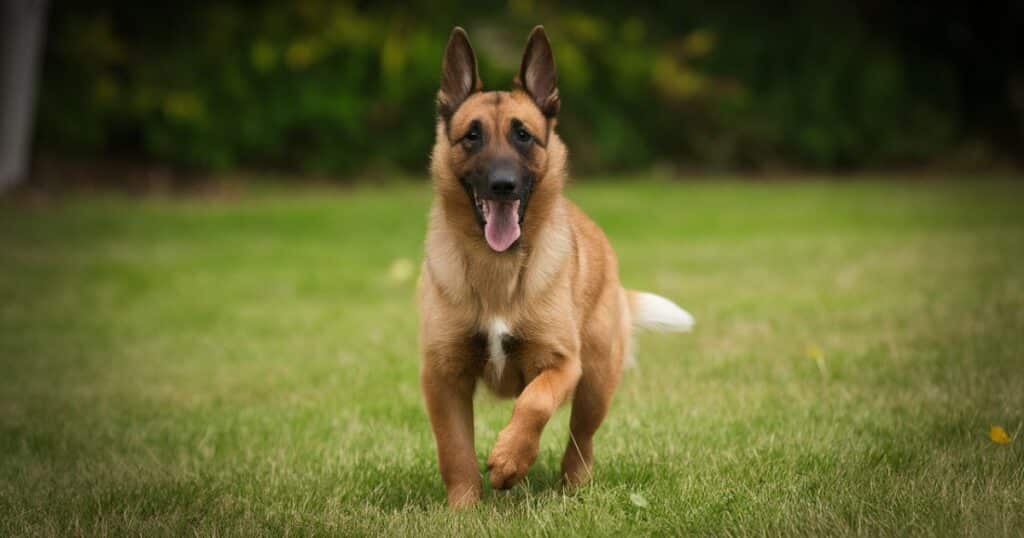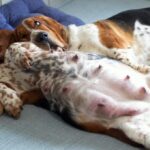Have you ever found yourself captivated by the striking appearance of a Belgian Malinois? These exceptional dogs aren’t just renowned for their incredible intelligence, loyalty, and work ethic – they also come in a mesmerizing array of coat colors. From the classic fawn sable to the ultra-rare blues and whites, the world of Belgian Malinois hues is a fascinating one.
Lately, you may have noticed these amazing canines stealing the spotlight in movies like John Wick or working alongside the military and police. But did you know their coats come in a brilliant rainbow of shades? Well, it’s time to dive into the full spectrum of Belgian Malinois colors and explore what makes each one unique.
The Quintessential Belgian Malinois Color – Sable
When you picture a Belgian Malinois, the iconic sable coat pattern is likely the first thing that comes to mind. This is the quintessential look for the breed – a rich, glowing base coat ranging from light tan to deep mahogany, accented by striking black tips on the hairs. But the true hallmark of the sable Malinois is the distinctive black mask that covers the face, almost like they’re wearing a superhero’s cowl.
While they all share the same basic sable and mask pattern, there’s still plenty of variety to be found. The intensity of that black mask can differ, with some dogs rocking a more subtle, narrower mask while others sport an extensive mask that cascades down their cheeks and forehead. The base sable shade also varies, with some Mals flaunting a light, wheaten hue and others a deep, burnished copper.
Out of the Ordinary: Rare and Unique Belgian Malinois Colors
The Stunning Black Belgian Mal
Solid black might seem like an unusual color for a Belgian Malinois, but these striking dark-coated dogs do exist! Their inky ebony fur is actually the result of crossing Malinois with the long-haired Groenendael variety of Belgian Shepherd. While not adhering to the breed standard, these black Mals are prized by some working dog breeders who prioritize performance over appearance.
But there’s more complexity to black Mals than meets the eye. Some inherit a “dominant black” gene, meaning at least one parent had to be solid black. Others are “recessive blacks” where two typical sable-patterned parents just happened to both carry the recessive black gene. While the solid black coat is considered a fault in the show ring, it hasn’t stopped these special pups from excelling in security, protection, and enforcement roles.
Read Also More: HOW MUCH DOES IT COST TO DECLAW A CAT?
The Mystic Blue Belgian Malinois
If you thought black Malinois were unusual, just wait until you see the blue ones! These cool-toned dogs with their ethereal silver-blue coats are among the rarest of the rare in the Malinois world. Their unique shading, which can range from a pale platinum to a deep charcoal, is caused by something called color dilution.
Essentially, it’s a result of the pigment in their coats being muted or dimmed by genetic factors. And the effect isn’t just limited to their fur – blue Mals also have slate-gray noses, paw pads, and eye rims to match that icy cool vibe. While hauntingly beautiful, there is a minor risk that this dilution can lead to a condition called Color Dilution Alopecia (CDA) which can cause patchy hair loss. Most blue Malinois live perfectly healthy lives.
The Rich Liver Hue
Imagine the decadence of a chocolate truffle or a well-aged bourbon. That’s the indulgent vibe given off by the ultra-rare liver or chocolate brown Belgian Malinois. Instead of the usual black pigments in their coats, these dogs produce a deep, luxurious brown eumelanin. And the effect extends to their whole body – from their warm toffee-colored coats to their rich cocoa-hued noses, eye rims, nails and paw pads.
To produce a liver Mal, both the mother and father have to carry the specific “brown” gene. When two of those gene copies combine in a puppy, you get this luscious chocolate dream of a dog. While not technically part of the breed standard, there’s no denying the striking beauty of their warm, comforting tones.
The Exotic Brindle Pattern
Reminiscent of a wild creature’s stripes or a soldier’s camouflage, the brindle pattern adds an exotic, almost mystical flair to a Belgian Malinois’ appearance. And while it’s considered a fault according to breed standards, these zebra-esque Mals still turn heads with their striking coats.
So how does the brindle pattern emerge? It’s essentially a layer of dark vertical striping that appears over the dog’s base tan coat color. Since brindle is a dominantly inherited trait, it can’t just occur spontaneously – brindle Mals always have at least one brindle parent passing it along.
There’s an interesting historical footnote tied to the brindle trait too. Belgian Shepherd fanciers actually started breeding away from brindles purposefully about a century ago to help distinguish their breed from the closely related Dutch Shepherds who embrace the brindle look. But in the world of performance and working dog breeders who care more about ability than aesthetics, the coveted brindle pattern continues to appear.
The Ghostly White Malinois
While the sight of a snowy white Belgian Malinois might make you do a double-take, I have to clarify – there’s really no such thing as a true “white” version of this breed. Any extremely pale or white-appearing Mals actually have what’s called an “extreme red” coat color caused by inheriting two copies of a gene that dilutes their pigment to an almost colorless cream or ivory shade.
But here’s the key thing – all properly bred Malinois are supposed to have that distinctive inky black mask over their faces. And since the white/extreme red colored dogs can’t produce any black pigment at all, any alleged “white Malinois” you come across were most likely created by unethical breeders crossing the breed with other white-coated dogs. So while they may visually resemble a pale Ghost Mal, their backgrounds raise some serious questions.
(Other potential sections: Agouti or “Wolf Sable” pattern, Black & Tan markings)
Masks, Shading and Other Distinctive Traits
Beyond just the base coat colors, Belgian Malinois also have some other distinguishing pigment-related traits that are essential to their appearance and tied to breed standards. We’ve already covered the iconic black mask, but did you know the ideal mask fully covers the muzzle, extends up over the eyes, and causes the ears to be solid black too?
The size and intensity of that mask can range quite a bit though. On some Mals, it’s a rather narrow, subtle mask just framing the eyes and muzzle. But others have incredibly expansive masks that make it look like they’re wearing a deeply shadowed head cowl cascading down their cheeks and across their forehead.
Then there’s the sable shading – those striking black tips on the hairs creating a dusting or overlay over the dog’s tan base coat. The degree of shading can also vary drastically between individual Mals. Some are “clear sables” with just a hint of black tipping on the haunches and tail. Others are incredibly heavily shaded, to the point they almost appear solid black from a distance but you can see the glowing tan undercoat peeking through.
The shading often develops and intensifies as the Malinois matures from a puppy into an adult too. In fact, many Mal puppies are born looking surprisingly dark, only to gradually become lighter before that adult shading sets in.
Other pigment-related features to look for: The breed standard calls for deep brown eyes, complemented by a solid black nose and black-rimmed eyelids. While blue or brown diluted pigments in the eyes/noses/nails are considered faults, they can still occur rarely in certain color varieties like the blues and livers we discussed earlier.
Why Coat Color Shouldn’t Matter (But Here’s What to Know)
As you’ve no doubt realized by now, the world of Belgian Malinois colors is an intricate and fascinating one. From the classic sables to the rarer shades of black, blue, liver and brindle, there’s an incredible diversity of hues found in this exceptional breed.
But here’s the critical thing to understand – coat color is just the icing on the cake. When it comes to Belgian Malinois, their truly amazing qualities lie in their CopyRetry
Why Coat Color Shouldn’t Matter (But Here’s What to Know)
As you’ve no doubt realized by now, the world of Belgian Malinois colors is an intricate and fascinating one. From the classic sables to the rarer shades of black, blue, liver and brindle, there’s an incredible diversity of hues found in this exceptional breed.
But here’s the critical thing to understand – coat color is just the icing on the cake. When it comes to Belgian Malinois, their truly amazing qualities lie in their drive, intelligence, versatility and unwavering work ethic. These dogs aren’t bred to be pampered pets – they’re born and raised to take on the toughest jobs as military, police, and security K9s.
So while their coats might catch your eye, you should never prioritize color over soundness, health, and working ability when selecting a Belgian Malinois puppy or adult dog. Be very wary of any breeders hyper-focused on producing trendy “rare” colors at the expense of maintaining the breed’s outstanding temperament and physical traits.
“A good dog is a good dog, no matter what color they happen to be.” – Reputable Malinois Breeder
If a breeder seems to care more about exotic fur patterns than proven working bloodlines, mental and physical soundness, that’s a big red flag. The same applies if they’re using unethical breeding practices like crossing Mals with other breeds just to create novelty white or other atypical coats.
Instead, do your research to find a respected, ethical breeder with a strong history of producing stellar Malinois prospects for real-world working roles and competitions like protection sports, detection work, herding trials and more. Their dogs might be sables, blacks, or blues – but you can bet they’ll have the trademark courage, athleticism and off-the-charts drive the Malinois breed is famous for.
While all the unique coat colors we covered are striking in their own ways, they pale in comparison to the true magic of the Belgian Malinois themselves. These amazing dogs will blow you away with their intelligence, eagerness to learn and seemingly inexhaustible engines. So by all means, admire their gorgeous coats – but appreciate them for their astounding abilities first and foremost.
Conclusion
As we’ve explored, the Belgian Malinois truly is a breed of many colors – from the iconic sable standard bearer to the rarer ebony, silver-blue and chocolate-brown stunners. Each hue has its own unique backstory of genetics, breed history or breathtaking quirks of pigmentation.
But regardless of whether they rock a classic fawn coat, a wild brindle pattern or one of the other distinctive looks, all Belgian Malinois share the same extraordinary blend of athleticism, courage, keen instincts and unmatched loyalty that make them such revered working dogs.
So go ahead and revel in their striking coat colors. Marvel at the sleek ebony Mal patrolling alongside law enforcement, or the ghostly pale pup with the soulful gaze. But remember, their true beauty lies in those keen senses, that brilliant problem-solving mind, and the sheer force of will and devotion that allows them to run towards danger without hesitation while others flee.
These Dogs of Many Colors are truly multifaceted marvels, uniquely equipped to serve humanity as protectors, life-saving rescuers, trusted colleagues and cherished canine companions. Their stunning coats are just superficial blazes of glory hinting at the inner radiance waiting to be unleashed when they’re allowed to pursue the jobs they live for. That’s the real magic of the Malinois.

Elax is a seasoned writer with five years of experience specializing in articles focused on pets. His passion for animals and extensive knowledge shines through his engaging and informative writing style, captivating readers with insights into pet care and companionship. With a knack for crafting compelling content, Elax brings a wealth of expertise to the realm of pet-centric literature on your website.







